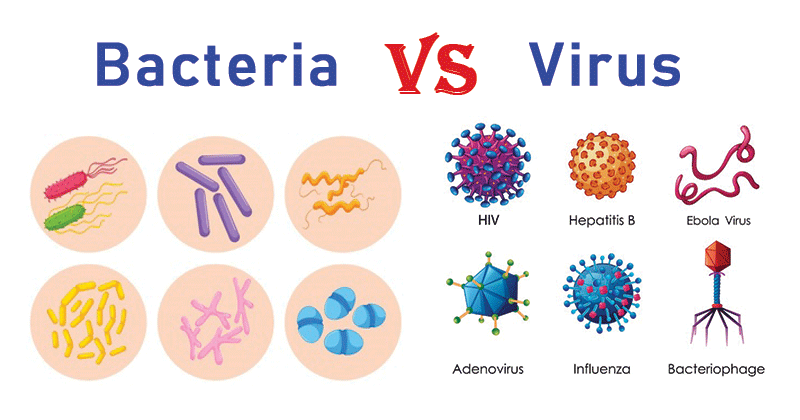
Interesting Science Videos
Some of the differences between bacteria and virus are as follows:
| S.N. | Character | Bacteria | Virus |
| 1. | Cell type | Prokaryotic cells | Acellular |
| 2. | Number of cells | Single-celled | No cell |
| 3. | Size | Larger than viruses (0.3-2 μ) | Minute (0.02-0.3 μ) |
| 4. | Microscopy | Visible under Light Microscope. | Visible only under an Electron Microscope. |
| 5. | Shape | Common bacterial cell shapes include cocci (spherical), bacilli (rod-shaped), spiral, and vibrio (comma-shaped). | Viruses typically have spherical (polyhedral), rod-shaped, or helically shaped capsids while some viruses, such as bacteriophages, have complex shapes. |
| 6. | Cellular Machinery | Possesses a cellular machinery | Lack of cellular machinery |
| 7. | Type of organism | Mostly intercellular organisms (i.e. they live in-between cells); some intracellular. | Intracellular organisms (they infiltrate the host cell and live inside the cell). |
| 8. | Structure | Organelles and genetic material within a cell wall | Genetic material within a capsid, some have an envelope membrane. |
| 9. | Cell wall | Cell wall made of peptidoglycan and lipopolysaccharide. | No cell wall. Protein coat presents instead. |
| 10. | Cellular membrane | Cell membranes are present. No sterol except in Mycoplasma cells which have cholesterol. | Some are enveloped but have no membrane function. |
| 11. | Genome | DNA and RNA 1 chromosomeNo histones | DNA or RNA 1 nucleocapsid except in segmented or diploid viruses |
| 12. | Nucleic acid | DNA and RNA float freely in the cytoplasm. | DNA or RNA is enclosed inside a coat of protein. |
| 13. | mRNA | Mono- and poly-cistronic mRNA | Some have poly-cistronic mRNA and post-translational cleavage. |
| 14. | Cell organelles | Presence of non-membrane-bound cell organelles. | Absent. Uses host organelles; obligate intracellular parasites |
| 15. | Ribosomes | 70s ribosomes (30s+50s) | No ribosomes |
| 16. | Living attributes | Living organisms. | Between living and non-living things. |
| 17. | Replication | Binary fission (asexual). DNA replicates cells continuously. | It invades a host cell and takes over the cell causing it to make copies of the viral DNA/RNA. Destroys the host cell releasing new viruses. |
| 18. | The need for host cell | Able to reproduce by itself. | Need a living cell to reproduce |
| 19. | Other forms | In some spore-forming bacteria, sporulating forms can be seen. | Besides viruses, two other acellular forms exist Viroids and Prions. |
| 20. | Cells Infected | Animal, Plant, Fungi | Animal, Plant, Protozoa, Fungi, Bacteria, Archaea |
| 21. | Infection | Localized | Systemic |
| 22. | Induction of Fever | A bacterial illness notoriously causes a fever | A viral infection may or may not cause a fever. |
| 23. | Duration of illness | A bacterial illness commonly will last longer than 10 days. | Most viral illnesses last 2 to 10 days. |
| 24. | Diseases/Infections | Food poisoning, gastritis, and ulcers, meningitis, pneumonia, etc | AIDS, common cold, influenza, chickenpox, etc |
| 25. | Susceptibility to Antibiotics | Most bacteria are susceptible to antibiotics. | The virus does not respond to antibiotics. |
| 26. | Treatment | Antibiotics | Antiviral drugs |
| 27. | Beneficial use | Some bacteria are beneficial (as normal flora, probiotics, fermenters, etc.) | Viruses are not beneficial. However, a particular virus may be able to destroy brain tumors. Viruses can be useful in genetic engineering. |
| 28. | Examples | E. coli, Salmonella spp., Listeria spp., Mycobacteria spp., Staphylococcus spp., Bacillus anthracis, etc. | HIV, Hepatitis A virus, Rhino Virus, Ebola virus, etc. |

May you please send a PDF on my email centanekgomotso@gmail.com
WHAT ARE SOME TREATMENTS FOR BACTERIA AND VIRUSES
For bacteria you would use antibiotics and for viruses you should let your body get some rest.
very thankful
thank u for such interesting imformation. share as much as possible
Kindly send it
nice points pls send me pdf
plese add email id/whats’app no.
uh
Sent me pdf
Excellent Job. Thanks for sharing.
I will appreciate further information from your compendium.Kindly share in my mailbox: emmanuelolajutemu@gmail.com
Plz send me notes PDF microbiology
Please may you kindly send notes to my email johnnkhuwa7@gmail.com
Pls provide a whatsapp group so that we can get easy access to your writing every time.
Please send pdf file on my email address, ajaleel4774@gmail.com
Excellent notes please send to pdf in my mail lokeshbiradar984@gmail.com
Excelente
very helpful readable easy to understand..
Fungi, are they more closer to plant or animal? pls clarify in the light of morphology, structure, genetics, pathology e.t.c
Fungi are eukaryotic organisms, so possess membrane bound organelles. They are closer to animals.
Please send PDF notes my email noksvics@gmail.com
Thank you
Please I need PDF format of this note
Please send all notes you have on my email: I will be much appreciated thanks in advance , I’m doing my first year at University of Johannesburg South Africa
Sorry, PDF are not available, You need to see from website.
Very much interesting Sagar aryal
Plz, send notes pdf on my email id…
Plz, send notes pdf on my email id rupalishinde305@gmail.com
ok